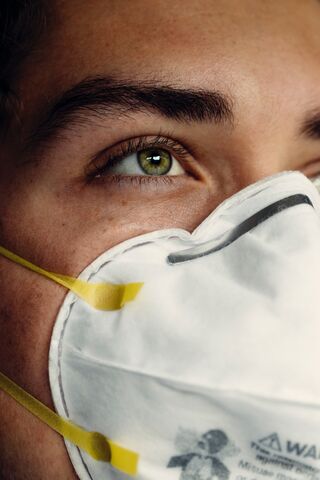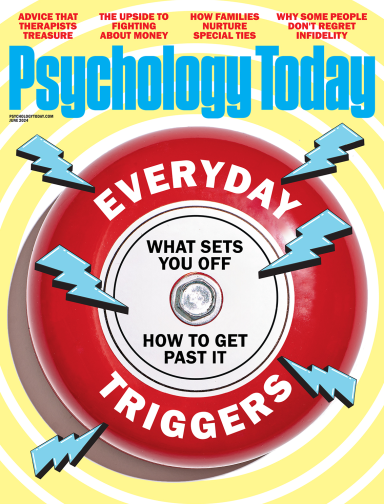Coronavirus Disease 2019
Can Mask Wearing Be a Clue to Someone’s Dishonesty?
People who wore their masks correctly showed more honesty than those who didn't.
Posted February 15, 2021 Reviewed by Lybi Ma
Key Points: There may be a link between honesty and how people choose to wear their mask. People who wore their mask only over their mouth or around their neck showed more dishonesty during an experimental game.
Imagine two strangers walking down the street. At first glance, can you tell if one of them is more honest than the other? Of course not. But now, thanks to Covid-19, maybe you can. Just take a look at how they wear their masks in places where masks are mandatory.

Suppose one person is wearing her mask properly, covering her mouth and nose. Suppose the other person only has his mask on his chin, or maybe down around his neck. From this difference alone, it could be that the second person is more likely to be dishonest in other situations as well.
That, at least, is what the economist Yossef Tobol at the Jerusalem College of Technology and his colleagues found in a recent study published in the journal Economic Letters. Their study was conducted in June of 2020 in Israel, at a time when masks had to be worn outside and violators were given a hefty fine by the police. The experimenters recruited 100 people on the street to be in the study who were wearing their masks properly, along with 100 people only wearing their masks on their chin or neck.
How Dishonesty Was Measured in the Study
As part of the experiment, everyone was given the die-under-the-cup task, a widely used behavioral measure of dishonest behavior. The way the task goes is that you are told to roll a die in private where no one else can observe you, with the understanding that there will be a greater financial reward the higher the roll you report. In Tobol’s study, a reported roll of 1 earned 1.2 euros, 2 earned 2.4 euros, and so on. At the time one euro was the equivalent of a bit more than one US dollar.
For the die-under-the-cup task, the question is whether participants will on average report a roll that is higher than chance would predict (chance = 3.5). This is indeed what Tobol found. For the group wearing their masks properly, the average score reported was 4.05.
This result is in line with many studies of honest behavior using a variety of different measures. These studies tend to find that people are willing to cheat to some extent if they think they can get away with it and get rewarded in the process. At the same time, participants tend to not cheat as much as they could. Why not just report a ‘6,’ for example, no matter what the roll is? Current research on honesty often attributes this restrained cheating behavior to a desire to preserve our ability to think of ourselves as honest people.
What about the group of people who were wearing their masks improperly? How did they report their die rolling task? There, the average reported roll was 4.91, which is a significant difference from the 4.05 of the first group. This second group as a whole was willing to break the rules when it came to Covid-19 safety, and it was also willing to break the rules in another situation as well.
The Connection Between Honesty and Mask-Wearing
This fits with the explanation that Tobol provides for why these people would have their mask on their chin or neck in the first place. Tobol speculates that they could quickly pull their mask up correctly in the presence of the police to avoid a fine, but otherwise did not care about complying with the requirement. This was an outward appearance of compliance, together with hidden deception, just like in the die-rolling task.
At this point, it is natural to wonder about a third group, namely those who weren’t wearing a mask at all. Fortunately, Tobol studied them too. For 100 people on the street who were not wearing a mask, their reported die roll was 4.21. Slightly higher than the 4.05 for the mask-wearing group, but not a statistically significant difference. At the same time, it is much lower than the 4.91 for the improper mask wearing group.
We might have initially expected the no mask group to cheat the most, of the three on the die task, since they were simply breaking the rules outright. But upon reflection the data makes sense. These are people who are not making any attempt to deceive anyone. They are blatantly violating the public requirement.
How people wear their masks, when doing so is mandatory, could be a highly visible clue to their degree of honesty. At the same time, these results need to be replicated in different countries. Other measures of honest behavior need to be used as well, besides the die-rolling task. Many more studies have to be done.
Someday, though, we might be able to predict people’s dishonesty by simply reading it right off of their faces.
References
This article also appeared in Forbes.
Tobol, Y., Siniver, E., & Yaniv, G. (2020). Dishonesty and mandatory mask wearing in the COVID-19 pandemic. Economics letters, 197, 109617. https://doi.org/10.1016/j.econlet.2020.109617




